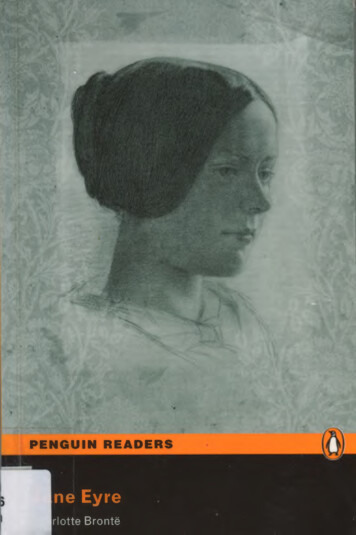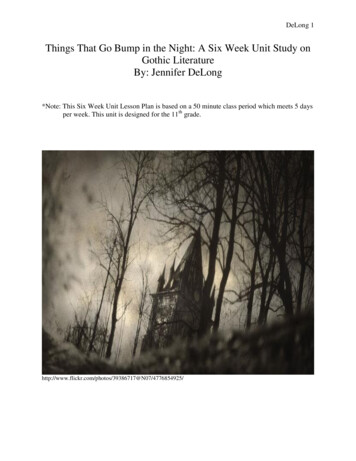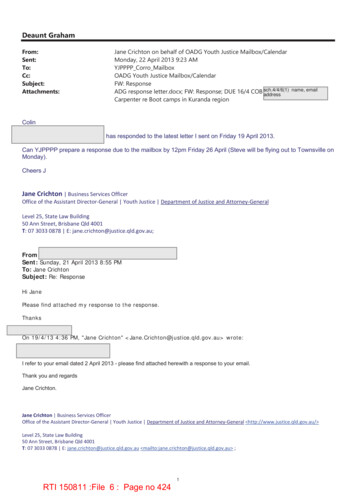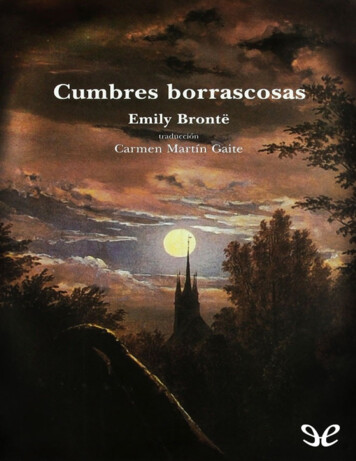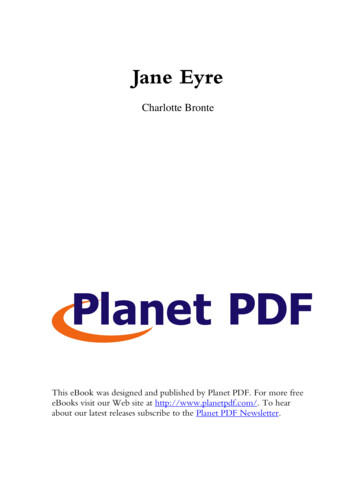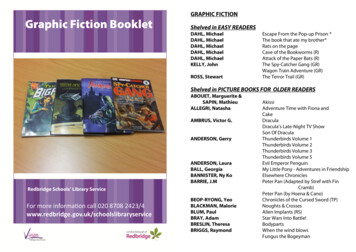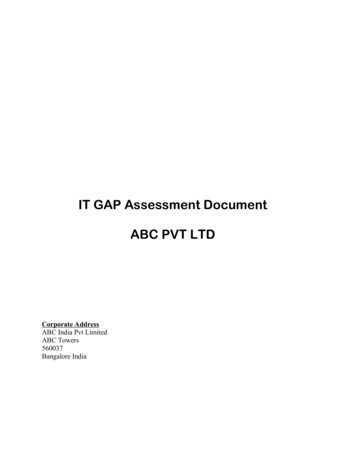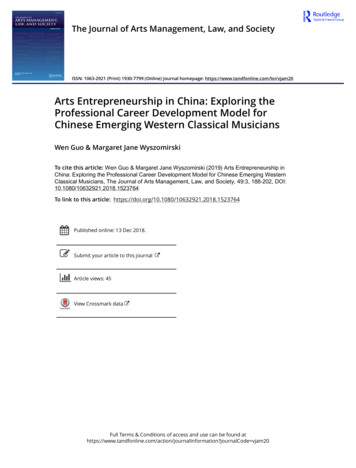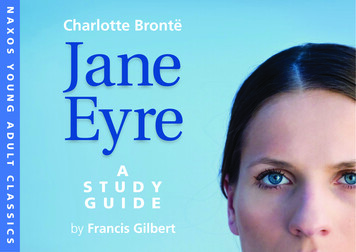
Transcription
NAXOSjane eyre – a study guide by francis gilbertCharlotte BrontëYOUNGA D U LTJaneEyreCLASSICSAS T U D YG U I D Eby Francis Gilbertpage 1
Contentsintroduction . 5contexts . 7Understanding Contexts .Contexts of Writing: Brontë’s Life .Selected Reading on Brontë’s Life .Contexts of Reading .781111structure and theme . 15Narrative Summary . 15The Influence of Genre – the Gothic Novel . 17critical perspectives . 19Is Jane Eyre a Subversive Novel? . 19Selected Reading on Jane Eyre . 21notes, quotes and discussion . 23glossary . 57study guide author: francis gilbert . 59page 3
IntroductionThis study guide takes a different approach from moststudy guides. It does not simply tell you more about thestory and characters, which isn’t actually that useful.Instead, it attempts to show how the author’s techniquesand interests inform every single facet of this classicnovel. Most study guides simply tell you what is goingon, then tack on bits at the end which tell you how theauthor creates suspense and drama at certain points in thebook, informing you a little about why the author mighthave done this.This study guide begins with the how and the why,showing you right from the start how and why the authorshaped the key elements of the book.page 5
ContextsUnderstanding ContextsIn order to fully appreciate a text, you need to appreciatethe contexts in which it was written – known as itscontexts of writing – and the contexts in which youread the book, or the contexts of reading.This is a potentially huge area to explore, because‘contexts’ essentially means the ‘worlds’ from which thebook has arisen. For the best books, these are many andvarious. The most obvious starting point is the writer’sown life: it is worth thinking about how and why theevents in a writer’s life might have influenced his or herfiction. However, you do have to be careful not to assumetoo much. For example, many critics think that theangelic, other-worldly character of Helen Burns in JaneEyre is a representation of Charlotte Brontë’s etherealsister Emily. This may be true, but you must rememberthat Helen is a character in her own right in the novel – avital cog in the narrative wheel, a literary construct andnot a real person!As a result, it is particularly fruitful to explore other contextsof writing. We can look at the broader world from whichCharlotte Brontë arose (Victorian society and its particular setof values), and consider carefully how, in her writing, she bothadopted and rejected the morals of her time. Other contextsmight be the influence of the literary world that Brontëinhabited (what other authors were writing at the time), howreligion shaped her views, and so on.Just as important as the contexts of writing are thecontexts of reading: how we read the novel today. Most ofpage 7
charlotte brontë – jane eyrea study guide by francis gilbertus, before we read a classic novel by Charlotte Brontë, havea lot of preconceived ideas about it. Many of us will haveseen one or more of the many film versions of the book,and/or been influenced by what we have already heardabout the Brontës. Your own personal context isimportant, too. I think female and male readers mayabsorb this novel differently – female readers perhapsfalling a little in love with Rochester themselves, and malereaders perhaps considering carefully whether they wouldmarry Jane. In order for you to fully consider the contextsof reading, rather than my telling you what to think, I haveposed open-ended questions that I believe to be importantwhen considering this issue.Some eminent literary critics have argued that CharlotteBrontë was a sexually repressed woman whose only outletfor all her passion was through writing.Surprisingly, this argument is not as absurd as it sounds.Brontë really does seem to have had a strong aversion tosex. She refused three offers of marriage, fell in love with amarried man whom she knew she could never sleep with,and when she did eventually marry the Reverend ArthurBell Nicholls (near the end of her life, when she was 38) itwas more out of pity than love. The dangers of having sexare amply illustrated in Jane Eyre (her most famous novel):Rochester and Bertha Mason’s sexual appetites get theminto no end of trouble. It has been argued that the illness ofwhich Brontë died was largely imaginary and that Brontëpreferred the idea of death to that of a ‘normal’ married life.But before we start suggesting that Brontë’s novels arethe product of a sexually repressed, neurotic woman, a fewpoints need to be taken into account. First, any sensible,intelligent woman living in Victorian England should havebeen scared stiff when contemplating the consequences ofhaving sex: there were no effective contraceptives at thattime, and a huge number of women died giving birth.Second, getting married – the only way for a ‘respectable’woman to have sex – entailed losing the few rights womenhad at that time: wives were expected to hand over alltheir property entirely to their husbands, until theMarried Women’s Property Act of 1870 and 1882. And, as amarried woman, Brontë had very little time to write,because she was too busy being a dutiful wife.Any careful examination of Brontë’s life makes it clearthat there were many other factors, other than sexualrepression, which motivated her to write. It is oftenoverlooked that the most significant spur for all theBrontë sisters’ mature writing was a desperate need formoney. In September 1845, when Charlotte discoveredsome of Emily’s poems and tried to get them published,life was precarious at the Haworth parsonage. The Brontësisters were the daughters of an ageing cleric from whomthey would inherit very little money; their brotherBranwell, on whom they had pinned great hopes ofmaking the family fortune, had become an unemployedalcoholic and drug addict; and their other money-makingventures – such as engraving, being governesses andsetting up a school at the parsonage – had all failed. As theeldest and most responsible child, Charlotte took it uponherself to promote all their writing as a way of securing anincome. The sisters had always been writers: as childrenthey had all invented fantastical, imaginary kingdoms, andwritten long and brilliant sagas about them. But Charlotte,a keen reader of fiction, was sharp enough to know thatthese private fantasies wouldn’t sell. So she set aboutwriting a more commercial novel, called The Professor,which, although rejected by a notable London publisher,page 8page 9Contexts of Writing: Brontë’s Life
charlotte brontë – jane eyrea study guide by francis gilbertreceived some favourable feedback. Encouraged, Charlottewrote Jane Eyre, an even more commercial book,combining as it did all the Gothic, fairytale and realistelements which were popular at the time. She also tookthe wise step of publishing her novels and those of hersisters under genderless pseudonyms, so that they wouldn’tbe dismissed by the male critics as ‘women’s novels’.All the great Brontë novels – Jane Eyre, Emily’s WutheringHeights and Anne’s Agnes Grey – appeared within a fewmonths of each other and caused an immense stir. Thecritics were convinced that they were all written by thesame person. In 1848, Charlotte, despite being chronicallyshy and reluctant to leave her possessive father, travelledwith Anne to London and created huge excitement in thepress by revealing the true identity of the authors.But the next two years were horrific for Charlotte: herwayward brother Branwell died of alcoholism and herstoical and introverted sister Emily died of tuberculosis,which also claimed the life of Anne a year later.Devastated by these losses, Charlotte persevered andarticulated her sense of pain and loneliness in her mostmature and difficult novel, Villette. This novel draws uponher experiences in Brussels where she had stayed a coupleof times during 1842–3 while training to be a teacher. Theculture and romance of the city had awakened her mind,while her unspoken obsession with her instructor,Monsieur Heger, a married man with children, had nearlybroken her spirit. However, like Jane Eyre, Charlottegained control of her feelings (unlike her brother Branwell,who had been rejected by a married woman to whom hehad declared his love). The tale of her unrequited feelingswas poured into a great deal of her fiction, Villette beingthe most obvious example, although fragments of herobsession with Heger can also be found in Jane Eyre.So we are back to the issue of frustrated love, but only avery narrow-minded critic would claim that the solereason for the existence of Brontë’s great novels wassexual neurosis.page 10page 11Selected Reading on Brontë’s LifeElizabeth C. GaskellThe Life of Charlotte BrontëTwo Volumes (Penguin Classics; first published 1857)A controversial book and the first indispensable account ofBrontë’s life; it remains indispensable today.Juliet BarkerThe Brontës(Phoenix; 1994)A landmark book on the family, brilliantly researched.Lyndall GordonCharlotte Brontë: A Passionate Life(Vintage; 1995)A biography which sets out to overturn the conventional viewof the suffering heroine. It paints the portrait of a passionate,complex woman and novelist.Contexts of ReadingToday we read Jane Eyre very differently from the way inwhich the Victorians would have read it. First, ourattitudes towards marriage mean that the plot isundeniably set in the past. Unlike some Victorian novels,Jane Eyre could not be updated to a modern day narrativewithout losing the central dilemma of the book: todayRochester could easily obtain a divorce and would not havehidden his wife in the attic unless he was psychotic –
charlotte brontë – jane eyrea study guide by francis gilbertwhich, for all his passionate ways, he is not! This means weview the novel ‘historically’, appreciating that it makessense within the context of its time, but that it depicts anera that has, mercifully, passed in the western world.Nevertheless, it continues to inspire film-makersbecause, while its central plot device is outmoded, itstheme of one woman’s search for love and justice isperhaps even more relevant now than it was in Victoriantimes. A well-educated, high-achieving, feisty woman likeJane Eyre would have been an exception in VictorianEngland, whereas today these characteristics are perhapsmore common. The sort of problems that Jane has toconfront – dealing with difficult men, soothing distressedfriends, fighting against the prevalent sexism of theculture – are just as pertinent now as they were then.Moreover, the central dilemma of the book – whether tochoose a passionate, difficult partner who promises her aninsecure but romantic life, or someone sensible but cold,who offers a secure but dull life – is very much an issue formen and women today. The binary opposites that Brontësets up of insecurity/security, of passion/conformity, ofmale desire/female desire are all opposites that we try tojuggle in our own minds.Our knowledge of the Brontës colours much of what isin the text; before most of us read it, we are aware that thestory comes shrouded in the misty Yorkshire moors,cloaked in the tragic story of the dying sisters and theiralcoholic brother, and suffused with the mystery of thesisters’ brilliant, romantic imaginations. Many of us willhave seen one of the numerous film versions, with ourminds already coloured by Hollywood images of broodingpassion and Gothic romance. In this sense, reading thetext is like searching for the ‘real story’, an act of‘unearthing the mystery’ of Charlotte Brontë’s mind asmuch as enjoying the narrative.Remarkably for such an interpreted text, it remainsfresh. What leaps out most is the living, vibrantrelationship between Rochester and Jane, which must bethe key reason why it remains such an enduringly popularbook. How hard many authors have struggled since thento capture such a vivid romance! The power of Jane Eyreremains undimmed more than 160 years later because ofBrontë’s characterisations of hero and heroine: theirflirtatious, quick-witted banter, their ability to build uponeach other’s thoughts, their genuine love for each other. Atthe heart of the novel is the power of their love; in thissense, the novel is timeless.page 12page 13
Structure andThemeNarrative SummaryThere are many ways of summarising this novel because itis so long and contains many sub-plots, all involving themain protagonist, Jane Eyre. However, at its heart is thenotion that it is an edited ‘autobiography’ – the story ofJane’s life. This is fascinating, because an autobiographyis, by its very nature, ‘non-fictional’ and ‘truthful’, achronological personal account of a life; but clearly this is afictional narrative. This element of autobiography enablesBrontë to step aside from some of the problems thatnovelists encounter, e.g. that of generating a story inwhich all the events ‘interconnect’. For all its Gothicflights of fancy, there is a realism about Jane Eyre –particularly in its descriptions of the squalid conditions atLowood school, which link it with the socially campaigningnovels of Mrs Gaskell.However, many of the settings and events are basically‘Gothic’ in conception: lonely, desolate mansions;terrifying dreams; ghostly laughs in the night; troubled,charismatic, Byronic men; mad women in attics; andimprobable coincidences. What makes the novel soenticing is the fact that there is realism in its psychology:Brontë creates a set of believable emotional responses inJane Eyre that hook the reader from the first page. This isbecause the overwhelming emphasis of the book is its‘autobiographical’ impulse: Brontë’s repeated insistence onpage 15
charlotte brontë – jane eyrea study guide by francis gilbertdescribing, in depth, Jane Eyre’s feelings and thoughts.So Brontë shapes her narrative around Jane’s ongoingstruggle to find love and justice in the world. Sometimesthese two themes are quite distinct. At the beginning of thebook there is no real sense that the young Jane is in desperateneed of parental love (although this is hinted at); it is morethat she is furious with the injustice of her treatment at thehands of the horrid, spoilt child John Reed and his mother,the despicable Mrs Reed. However, the two themes cometogether when the adult Jane learns of Rochester’s bigamy:she has to weigh up her need for just treatment against hercraving for Rochester’s love. Her desire for justice wins outand she leaves Rochester. Similarly, the themes convergeagain when St John Rivers proposes to her: he suggests thatthey live married life as missionaries and bring justice to poorparts of the world, but he offers no real love. This time Jane’sneed for love triumphs and she rejects him.We could break down the novel into the followingstructure: Jane’s refusal to marry her newly discovered cousin, the curateopening Orphan Jane Eyre’s childhood and schooling Her battles for justice and survival against her adopted familydevelopment of the narrative Jane’s arrival at Thornfield and her growing love for its ownerMr Rochester Her acceptance of his proposal of marriagecrisis Jane’s discovery of Rochester’s mad wife in the attic, and her refusal, despite her love for him, to become his mistress becauseit would be morally unacceptableHer running away and finding sanctuary at Moor Houseclimaxpage 16 St John Rivers, and become a missionary wife in a loveless but‘just’ marriageHer hearing of Rochester’s cry in her head, and her return toThornfield to learn of the death of Rochester’s wife and thedestruction of Thornfield itselfresolution Her marriage to RochesterThe Influence of Genre – the Gothic NovelHaving been stung by the rejection of her novel TheProfessor, Brontë very consciously shaped the narrative ofJane Eyre around events that might typically be found inGothic novels. This was a hugely popular genre which haddeveloped in the late eighteenth century. It usuallyinvolved a long and complicated narrative of a damsel indistress, trapped in some ghastly castle or mansion,besieged by a sexually rapacious and devious aristocrat,haunted by ghosts and ghouls, chased by innumerablenasties throughout the story, before being rescued by aknight in shining armour, a morally upright man.Much of what happens at Thornfield, the home of MrRochester, follows this pattern. In many ways, Rochesterlives up to the stereotype of the morally suspect, sexuallyrapacious aristocrat: he attempts to lure Jane falsely intomarriage, and then, when he is discovered to have a wife,still persists, claiming that she could live as his mistress.His motivations are undoubtedly sexual. He is presentedas a bad-tempered, tempestuous, passionate man who hasscant regard for the strict moral codes of the day.Moreover, he inhabits a classic Gothic domain: themysterious and wonderful Thornfield Hall. It is a placehaunted by strange ghostly laughs in the night,page 17
charlotte brontë – jane eyreunexplained fires, terrifying and inexplicable acts ofviolence, vast, misty grounds and, perhaps mostimportantly, forbidden realms: corridors and floors androoms that are out of bounds. It is, as Jane Eyre herselfnotes, a true Bluebeard’s castle.This texturing of Thornfield Hall is deliberate uponBrontë’s part, and it is one of the reasons why the novel isso popular now. There is perhaps no better Gothic novel inEnglish. It is marvellously, wonderfully, brilliantly wellwritten because it is so convincing. As we noted before, itis the psychological realism that Brontë brings to thecharacter of Jane Eyre – her feisty, earthy, indomitablereactions to the events and characters of Thornfield –which make the Gothic elements so plausible.At the heart of this plausibility is Brontë’s refusal toallow her main protagonist to be painted as a stereotypicalGothic heroine. Parodied by Jane Austen in her take-off ofthe Gothic novel Northanger Abbey, your average Gothicheroine is forever frightened, forever terrified, alwayspassively running away, avoiding calumny and destruction.Brontë makes a conscious choice for her Gothic heroine tobe ‘active’. Rather contrary to the stereotype, Jane isforever rescuing the man. This starts with the very firstscene in which she encounters Rochester: she helps him upafter he has fallen from his horse. Later on, she saves himfrom being burnt to death in his own bed by his first wife.She even ignores his attempts to persuade her to stay atthe house when she learns that her aunt, Mrs Reed, isdying, deciding of her own accord to leave the Gothicrealm (a very unusual event in novels of this type).She is, throughout, the decider of her own destiny. Sherejects Rochester’s offer of living in sin and leaves; butthen she more or less engineers her own proposal ofmarriage at the end of the novel, happy to be dominantover the ‘crippled, blind’ Rochester.page 18CriticalPerspectivesIs Jane Eyre a Subversive Novel?Is Jane Eyre a subversive novel? One contemporary critic,Mrs Oliphant, was quick to argue that it was. In May of1855, eight years after the book was published, she wrotein Blackwood’s Magazine: ‘What would happen if social andsexual inferiors asserted that they were the equals of theirsuperiors? .here is your true revolution.’ Mrs Oliphant,along with numerous feminist critics, was convinced thatJane Eyre’s demand to be treated as Mr Rochester’s equal,despite her lowly social circumstances and her gender,made the novel truly radical.During the Victorian age, women were considered inferiorto men: they were not entitled to vote or study at universityand there were few occupations open to them. Once theywere married, all their wealth became their husband’s andthey had no rights over their children or property. Withinthis context, Jane’s comment, ‘but women feel as men feel.they suffer from too rigid a restraint’, is a very radical one:most people considered that women did not have thesensibilities of men. Likewise, Rochester’s insistence thatJane was his equal was definitely shocking forcontemporary readers: very few ‘respectable’ husbands ofthe time ever seriously entertained the notion that theirwives were as intelligent as they were.But there are aspects to the novel which are deeplyconservative and seem to endorse an inequality betweenpage 19
charlotte brontë – jane eyrea study guide by francis gilbertthe sexes and classes. Most troubling is the depiction of BerthaMason. Rochester informs Jane that it is Bertha’s sexualappetites, together with a madness which runs in her family,that has destroyed her sanity. And yet Rochester himself hasconfessed to a promiscuous past. Whereas Jane’s marriage toRochester indicates that he is forgiven for his past sins,Bertha’s imprisonment shows that she is punished for hers.The psychoanalytic feminist critics S.M. Gilbert andS.!Gubar are of the opinion that Bertha represents the trulysubversive element in the novel. In their celebrated bookThe Madwoman in the Attic (London, 1979) they argue thatBertha breaks all the conventions to which women wereexpected to conform: she is strong, violent andpromiscuous, and from a totally different culture comparedto everyone else in the book. The ultimate conservatism ofthe book is underlined by the way in which Bertha’s spiritand culture are either crushed or ignored.Other critics, such as Hermione Lee, have countered thistheory, suggesting that Jane is constantly rebelling againstthe male-dominated culture of the time and carving herown ‘feminist’ path. Her initial outcry against John Reed’sbullying, her rebuke to Mr Brocklehurst, her abandonmentof Rochester, and her rejection of St John Rivers are allindications that she won’t be bullied, cajoled or persuadedinto accepting a status quo with which she is not content.But, as Felicia Gordon points out in her excellent book APreface to the Brontës (Longman 1989), for all her rebelliousspirit, Jane does yearn for a benevolent man to take her underhis wing. At the beginning of the novel Jane wishes that heruncle, Mr Reed, were alive so that she wouldn’t be subjected tothe tyranny of Aunt Reed’s rule. At the end, once Rochester isrelieved of his mad wife and the question of breaking one ofthe Lord’s commandments has been dismissed, Jane finallydoes submit to the authority of her husband.Charlotte Brontë herself was a deeply conservative, God-fearing woman who, despite arguing that women shouldenjoy more rights, did not want to question thefundamental tenets of the patriarchal society in which shelived. However, her genius as a writer forced her to subvertmany of the literary conventions of the time: no romanticnovels of the period contain such a strong, wilful heroineas Jane, while no Gothic novels depict a character asdisturbing as Bertha Mason or a protagonist as complex asRochester. Even today, very few romantic novels wouldhave the heroine rescuing the hero even once, let alone twice.The brilliance and complexity of Jane Eyre are derivedfrom its being simultaneously a very subversive novel anda deeply conservative one, a novel which radicallyquestions the patriarchal status quo of society and yetultimately argues for a benevolent male authority.page 20page 21Selected Reading on Jane EyreFelicia GordonA Preface to the Brontës(Longman; 1989)Part of the Longman Preface series. An excellent shortintroduction to the Brontës: Gordon’s concise grasp of thehistorical and literary context makes this my favourite Prefacebook of this superb series.Penny BoumelhaCharlotte Brontë(Key Women Writers; 1990)A feminist critique of the book.Pauline NestorCharlotte Brontë(Rowman & Littlefield Publishers, Inc.; 1987)This provides a more traditional critique of the novel andBrontë’s work.
Notes, Quotesand DiscussionImportant extracts and quotations fromthe novel with commentary anddiscussion points.The discussion points below are deliberately questions with noright or wrong answers given. They are there to help you thinkin more depth about particular aspects of the book.n.b. All the following quotations are from the complete,unabridged text.From Chapter I‘Wicked and cruel boy!’ I said. ‘You are like a murderer –you are like a slave-driver – you are like the Romanemperors!’Here, Brontë introduces the key theme of the novel:injustice. And she creates in the reader huge sympathy forher character by showing the young Jane Eyre battlingagainst her oppressors without any signs of self-pity.! discussion pointWhere else in the book do we see the writer presentingtyrants in a harsh light?page 23
charlotte brontë – jane eyreFrom Chapter IIa study guide by francis gilbertFrom Chapter IVI thought it like one of the tiny phantoms, half fairy, halfimp.Imprisoned for being disobedient, Jane Eyre is locked in aRed Room and sees herself in the mirror, believing herselfto be ‘half fairy, half imp’, almost a ‘real spirit’. Thus,Brontë introduces a heavy Gothic element into the novel,but also subverts the Gothic by making the heroine a‘phantom’ herself. Later on, Rochester’s key way of flirtingwith Jane will be to call her an ‘elfin fairy’.!I thought the swift darting beam was a herald of somecoming vision from another world. My heart beat thick,my head grew hot; a sound filled my ears, which Ideemed the rushing of wings; something seemed nearme; I was oppressed, suffocated: endurance broke down;I uttered a wild, involuntary cry; I rushed to the doorand shook the lock in desperate effort.The Gothic atmosphere intensifies when Jane thinks shesees the ghost of the deceased Mr Reed in the room. Brontësets the tone for the novel in this chapter, always makingthe reader anxious to question whether the ‘Gothic’ horrorsJane is encountering are real or supernatural.‘Psalms are not interesting,’ I remarked.‘That proves you have a wicked heart; and you must prayto God to change it: to give you a new and clean one: totake away your heart of stone and give you a heart offlesh.’Mr Brocklehurst’s visit to the Reeds to prepare Jane forLowood School leads to Jane’s negative judgement of thePsalms and Brocklehurst’s response. It sets the tone forthe book’s continued attack on religious fundamentalism.! discussion pointWhere else in the book do we see Brontë attackingreligious fundamentalism in her presentation of thecharacters? For example, Brontë’s presentation ofBrocklehurst is highly satirical, suggesting a mockery ofhis ridiculously rigid thinking about the Bible; how andwhy does she do this here, and elsewhere in the book?What points arise from her implicit criticisms?From Chapter VRavenous, and now very faint, I devoured a spoonful ortwo of my portion without thinking of its taste; but thefirst edge of hunger blunted, I perceived I had got inhand a nauseous mess; burnt porridge is almost as badas rotten potatoes; famine itself soon sickens over it. Thespoons were moved slowly: I saw each girl taste her foodand try to swallow it; but in most cases the effort wassoon relinquished.! discussion pointWhere else in the novel are we uncertain whether an eventis real or supernatural? What are the genuine supernaturalevents of the novel? Or are there any? What do you thinkthe author’s attitude is towards the supernatural?Brontë’s portrayal of Lowood School was based on theauthor’s own experience of attending a school fordaughters of clergymen. The most persuasive presentationpage 24page 25
charlotte brontë – jane eyrea study guide by francis gilbertof the horrors of the school is in the description of thefood – its vile tastes and textures. Notice the novel’s shiftin tone here, moving from the high Gothic melodramathat was generated at Gateshead to the realisticdescriptions of a nightmarish girls’ school.gradual: my mind is at rest. I leave no one to regret memuch: I have only a father; and he is lately married, andwill not miss me. By dying young, I shall escape greatsufferings. I had not qualities or talents to make my wayvery well in the world: I should have been continually atfault.’‘But where are you going to, Helen? Can you see? Do youknow?’‘I believe; I have faith: I am going to God.’‘Where is God? What is God?’‘My Maker and yours, who will never destroy what Hecreated. I rely implicitly on His power, and confidewholly in His goodness: I count the hours till thateventful one arrives which shall restore me to Him,reveal Him to me.’‘You are sure, then, Helen, that there is such a place asheaven, and that our souls can get to it when we die?’‘I am sure there is a future state; I believe God is good; Ican resign my immortal part to Him without anymisgiving. God is my father; God is my friend: I loveHim; I believe He loves me.’‘And shall I see you again, Helen, when I die?’‘You will come to the same region of happiness: bereceived by the same mighty, universal Parent, no doubt,dear Jane.’!‘It is partly a charity-school: you and I, and all the rest ofus, are charity-children. I suppose you are an orphan: arenot either your father or your mother dead?’Here, the young Jane, mystified about why she isattending the school, asks another pupil about it. Thisleads to a long conversation in which aspects of theschool’s set-up and history are explained to her. Noticehow Brontë decides to deliver much of this importantinformation through dialogue, conveying implicitly JaneEyre’s bewilderment at being at the school and providing aconvincing child’s eye view of the world. Unusually for awriter of her time, she doesn’t smother the narrative inadult explanation.! discu
read the book, or the contexts of reading. This is a potentially huge area to explore, because ‘contexts’ essentially means the ‘worlds’ from which the book has arisen. For the best books, these are many and
